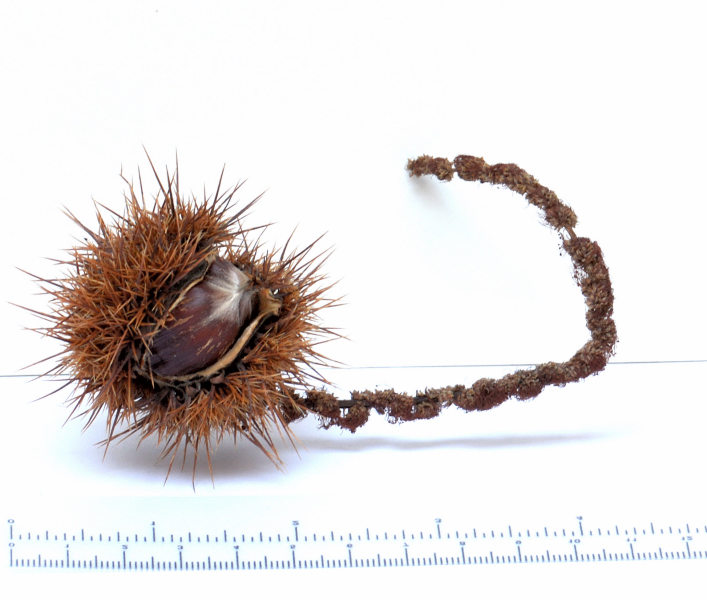Chestnut (Castanea sativa Mill.) comes from trees mainly found in the Mediterranean areas of Europe, Morocco, southern England, Belgium, Turkey, Romania, Caucasus.
The fruit has been used by traditional medicine to treat various diseases, such as cardioprotective, neuroprotective, antispastic, as well as against diarrhea and bronchitis for its stringent properties.

Studies
Over the past 50 years, chestnut has been thoroughly studied and interesting results have emerged on the photoprotective ability of extracts of its leaves against UV rays, due to their antioxidant peculiarity (1).
Antiviral activity of chestnut wood extract against avian reovirus (2) has also been demonstrated.
The part called "burs" or hedgehog has a low protein content, but an interesting range of essential amino acids (arginine, leucina) and non-essential (asparctic acid and glutamic acid, as well as proline). The lipid extract contains tocoferols and tocotrienols (3).
Chestnut studies
References____________________________________________________
(1) Gasperini S, Greco G, Angelini S, Hrelia P, Fimognari C, Lenzi M. Antimutagenicity and Antioxidant Activity of Castanea sativa Mill. Bark Extract. Pharmaceutics. 2023 Oct 14;15(10):2465. doi: 10.3390/pharmaceutics15102465. PMID: 37896225; PMCID: PMC10610242.
Abstract. Castanea sativa Mill. (Cs), a plant traditionally employed in nutrition and to treat various respiratory and gastrointestinal infections, possesses cancer chemopreventive characteristics. In particular, Cs bark extract previously demonstrated antiproliferative and pro-apoptotic activities against a leukemic lymphoblastic cell line. Starting from this evidence, the aim of this paper was to investigate the possibility to affect also the earlier phases of the carcinogenic process by evaluating Cs bark extract's antimutagenic properties, in particular using the "In Vitro Mammalian Cell Micronucleus Test" on TK6 cells performed by flow cytometry. For this purpose, since an ideal chemopreventive agent should be virtually nontoxic, the first step was to exclude the extract's genotoxicity. Afterwards, the antimutagenic effect of the extract was evaluated against two known mutagens, the clastogen mitomycin C (MMC) and the aneugen vinblastine (VINB). Our results indicate that Cs bark extract protected cells from MMC-induced damage (micronuclei frequency fold increase reduction from 2.9 to 1.8) but not from VINB. Moreover, we demonstrated that Cs bark extract was a strong antioxidant and significantly reduced MMC-induced ROS levels by over 2 fold. Overall, our research supports the assumption that Cs bark extract can counteract MMC mutagenicity by possibly scavenging ROS production.
(2) Lupini C, Cecchinato M, Scagliarini A, Graziani R, Catelli E. In vitro antiviral activity of chestnut and quebracho woods extracts against avian reovirus and metapneumovirus. Res Vet Sci. 2009 Dec;87(3):482-7. doi: 10.1016/j.rvsc.2009.04.007.
Abstract. Field evidences have suggested that a natural extract, containing tannins, could be effective against poultry enteric viral infections. Moreover previous studies have shown that vegetable tannins can have antiviral activity against human viruses. Based on this knowledge three different Chestnut (Castanea spp.) wood extracts and one Quebracho (Schinopsis spp.) wood extract, all containing tannins and currently used in the animal feed industry, were tested for in vitro antiviral activity against avian reovirus (ARV) and avian metapneumovirus (AMPV). The MTT assay was used to evaluate the 50% cytotoxic compounds concentration (CC(50)) on Vero cells. The antiviral properties were tested before and after the adsorption of the viruses to Vero cells. Antiviral activities were expressed as IC(50) (concentration required to inhibit 50% of viral cytopathic effect). CC(50)s of tested compounds were > 200 microg/ml. All compounds had an extracellular antiviral effect against both ARV and AMPV with IC(50) values ranging from 25 to 66 microg/ml. Quebracho extract had also evident intracellular anti-ARV activity (IC(50) 24 microg/ml). These preliminary results suggest that the examined vegetable extracts might be good candidates in the control of some avian virus infections. Nevertheless further in vivo experiments are required to confirm these findings.
(3) Esposito T, Celano R, Pane C, Piccinelli AL, Sansone F, Picerno P, Zaccardelli M, Aquino RP, Mencherini T. Chestnut (Castanea sativa Miller.) Burs Extracts and Functional Compounds: UHPLC-UV-HRMS Profiling, Antioxidant Activity, and Inhibitory Effects on Phytopathogenic Fungi. Molecules. 2019 Jan 15;24(2):302. doi: 10.3390/molecules24020302.
Abstract. Chestnut (Castanea sativa Miller.) burs (CSB) represent a solid waste produced during the edible fruit harvesting. Their usual disposal in the field increases the environmental and economic impact of the agricultural process. HPLC-UV-HRMS profiling revealed that CSB organic and aqueous extracts (CSB-M, CSB-H, CSB-A) contain several hydrolyzable tannins, mainly ellagitannins, and glycoside flavonols. Ellagic acid (EA) and chestanin are predominant components (5⁻79 and 1⁻13 mg/g dry extract, respectively). NMR analysis confirmed the chemical structures of the major constituents from CSB-M. The extracts displayed a significant scavenging activity against DPPH (EC50 12.64⁻24.94 µg/mL) and ABTS⁺ radicals (TEAC value 2.71⁻3.52 mM Trolox/mg extract). They were effective in inhibiting the mycelial growth (EC50 6.04⁻15.51 mg/mL) and spore germination (EC50 2.22⁻11.17 mg/mL) of Alternaria alternata and Fusarium solani. At the highest concentration, CSB-M was also active against Botrytis cinerea both in mycelium and spore form (EC50 64.98 and 16.33 mg/mL). The EA contributed to the antifungal activity of extracts (EC50 on spore germination 13.33⁻112.64 µg/mL). Our results can support the upgrading of chestnut burs from agricultural wastes to a resource of natural fungicides for managing fruit and vegetable diseases.
![]() Chestnut
Chestnut 



